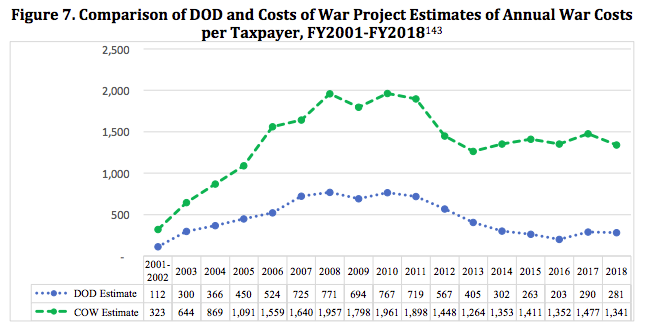The Department of Defense recently released an estimate of how much America’s post-September 11 wars have cost American taxpayers. According to the Pentagon, the wars in Afghanistan, Iraq, and Syria have cost $1.5 trillion since 2001. For each American taxpayer, that comes to $7,740. However, an estimate by the Cost of War Project at Brown University’s Watson Institute of International and Public Affairs finds that the Pentagon’s misses the real cost of the wars by a factor of three.
While the Cost of War Project’s report contains a great deal of information, these are the key figures:
- The total cost of America’s post-September 11 wars is $5.6 trillion
- The per taxpayer cost of the wars is $23,386
- Future interest payments on money borrowed for the wars will likely increase the national debt by $7.9 trillion
And this figure from the report shows how its estimate differs from the Pentagon’s:
The key difference in the estimates stems from what is included in them. The Pentagon’s estimate includes only the direct military costs of the wars. The Cost of War Project’s estimate includes those costs, as well as war-related expenses in other departments, such as the Department of State, Department of Homeland Security, and Department of Veterans Affairs. Some of the amounts included in the estimate as “war-related” costs are subject to debate, but the report’s author, Neta Crawford of Boston University, provides an annex that will be useful for researchers when deciding what amounts are appropriate to use in their own estimates.
An estimate that takes a full account of the financial impact of war is important as the United States grapples with more than sixteen years of war and potential future conflicts. However, as my colleague Karl Smith and I explained in a recent piece for War on the Rocks, information is not enough:
If war does not impact the American people in some tangible fashion, the public has little incentive to hold elected leaders accountable for recklessly initiating conflicts or for using military force counterproductively and inefficiently. Routine calls to reinstate the military draft are made based on the premise that if more Americans risked paying for the costs of war in blood, they might hold their elected leaders accountable. Research by political scientists Michael Horowitz and Matthew Levendusky has found that support for war drops among potential draftees and their families when the potential for conscription is introduced. However, modern military technology has rendered conscript armies anachronistic. A more plausible way to capture the public’s attention about America’s wars would be to help taxpayers internalize the costs of war in terms of treasure.
We suggest that a special-purpose tax to pay for the use of military force is the best way to internalize those costs. The Cost of War Project’s estimate provides a basis for understanding what such a tax should look like.
Read the entire report here.
